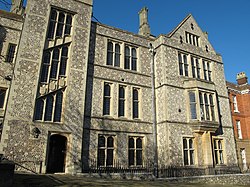
Hampshire County Council (HCC) is the upper-tier local authority for the non-metropolitan county of Hampshire in England. The council was created in 1889. The county council provides county-level services to eleven of the thirteen districts geographically located within the ceremonial county of Hampshire. The county council acts as the upper tier of local government to approximately 1.4 million people. It is one of 21 county councils in England.
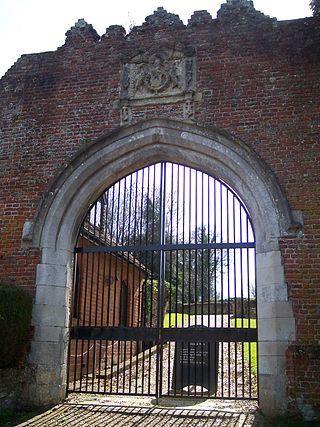
Basing House was a Tudor palace and castle in the village of Old Basing in the English county of Hampshire. It once rivalled Hampton Court Palace in its size and opulence. Today only parts of the basement or lower ground floor, plus the foundations and earthworks, remain. The ruins are a Grade II listed building and a scheduled monument.

Bangor Castle is a country house situated in Castle Park in Bangor, County Down, Northern Ireland. The building, which is also referred to as Bangor Town Hall and is now used as the offices of Ards and North Down Borough Council, is a Grade A listed building.

Winchester Castle is a medieval building in Winchester, Hampshire, England. It was founded in 1067. Only the Great Hall still stands; it houses a museum of the history of Winchester.

The Winchester Law Courts is a judicial facility just off the High Street in Winchester, Hampshire, England. As well as accommodating the Crown Court, which deals with criminal cases, the complex also accommodates the County Court and the Winchester District Registry of the High Court.

Taunton Shire Hall is a municipal building on Shuttern in Taunton, Somerset. The Shire Hall, which serves as a Crown Court, is a Grade II listed building.

Winchester Guildhall is a municipal building in the High Street, Winchester, Hampshire. It is a Grade II listed building.

The Shirehall is a municipal facility in Market Avenue, Norwich, Norfolk. It is a Grade II listed building.

The Old Town Hall, Richmond on Whittaker Avenue in Richmond, London is a former municipal building which from 1893 to 1965 served as the town hall for the Municipal Borough of Richmond.

Aberdeen Town House is a municipal facility in Castle Street, Aberdeen, Scotland. The town house, which is the headquarters of Aberdeen City Council, is a Category A listed building.

Rutherglen Town Hall is a municipal facility on the north side of Main Street in Rutherglen, Scotland. The town hall, which was the headquarters of Rutherglen Burgh Council, is a Category A listed building.

Havering Town Hall is a municipal building in Main Road, Romford, London. The town hall, which is the headquarters of Havering London Borough Council, is a Grade II listed building.

Wakefield Town Hall is a municipal building in Wood Street in Wakefield, West Yorkshire, England. It remains a venue for weddings and civil partnerships but is no longer the headquarters of Wakefield Council which is now based at County Hall. The town hall is a Grade I listed building.
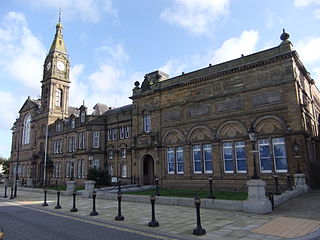
Bootle Town Hall is a municipal building in Oriel Road in Bootle, Merseyside, England. The building, which is the headquarters of Sefton Council, is a Grade II listed building.

Wednesbury Town Hall is a municipal building in Holyhead Road in Wednesbury, West Midlands, England. The structure, which was the meeting place of Wednesbury Borough Council, now operates as an events venue.

Tavistock Town Hall is a municipal building in Bedford Square, Tavistock, Devon, England. The structure, which remains the main venue for civic events in the town, is a Grade II listed building.
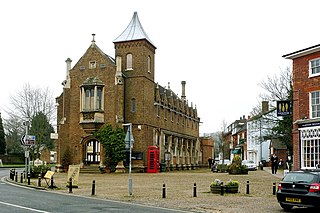
Woburn Town Hall is a municipal building in the Market Place, Woburn, Bedfordshire, England. The town hall, which has largely been converted for retail use, is a Grade II listed building.

Kingsbridge Town Hall is a municipal building in Fore Street, Kingsbridge, Devon, England. The town hall, which is currently used as a cinema, is a Grade II listed building.
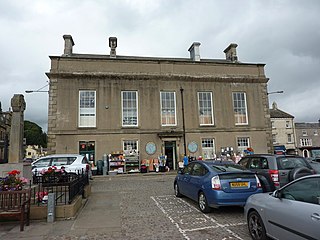
Leyburn Town Hall is a municipal building in the Market Place, Leyburn, North Yorkshire, England. The structure, which is used for retail purposes and as an events venue, is a grade II listed building.

Abram Council Offices is a municipal building in Warrington Road, Abram, Greater Manchester, England. The building is currently used as private apartments.
